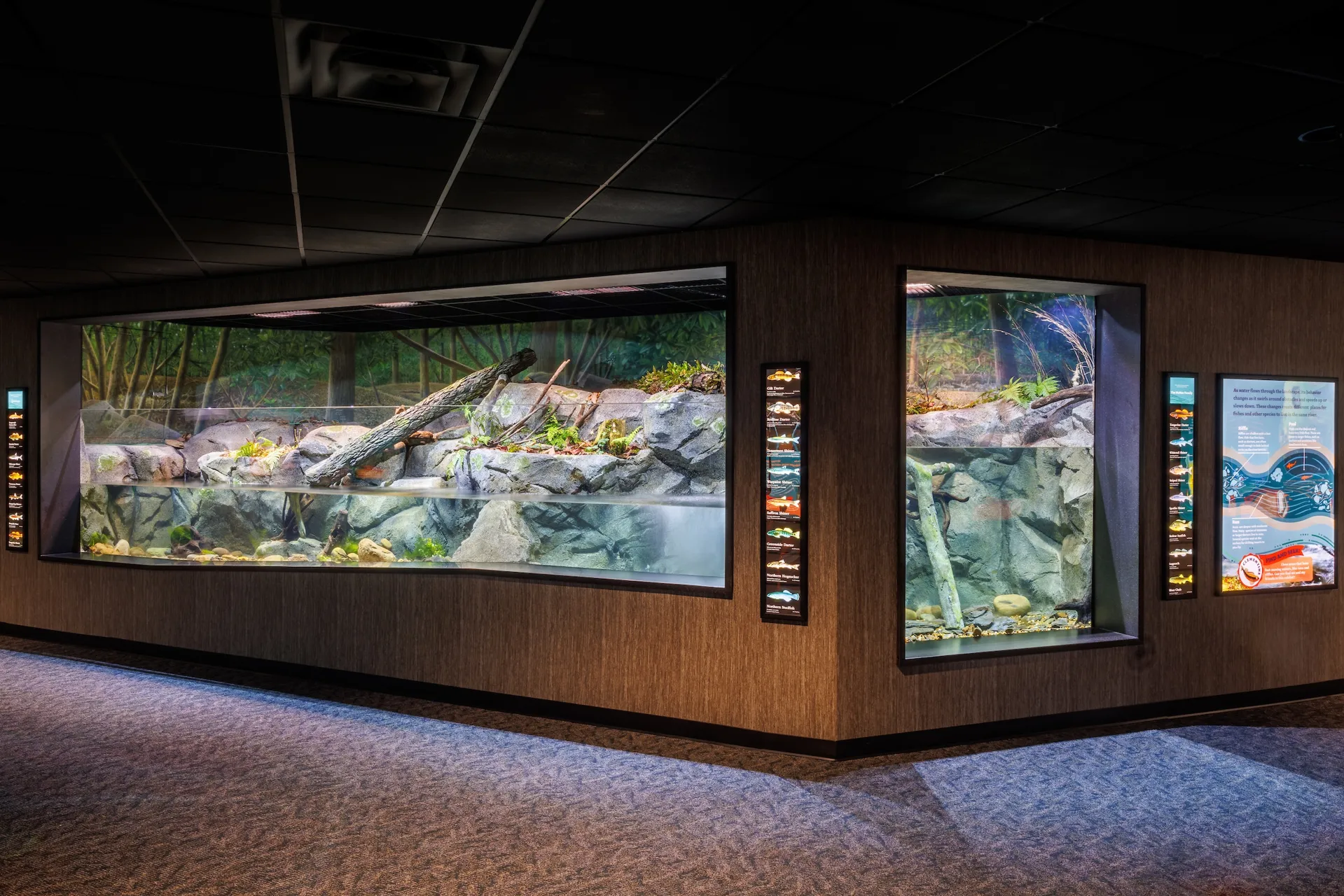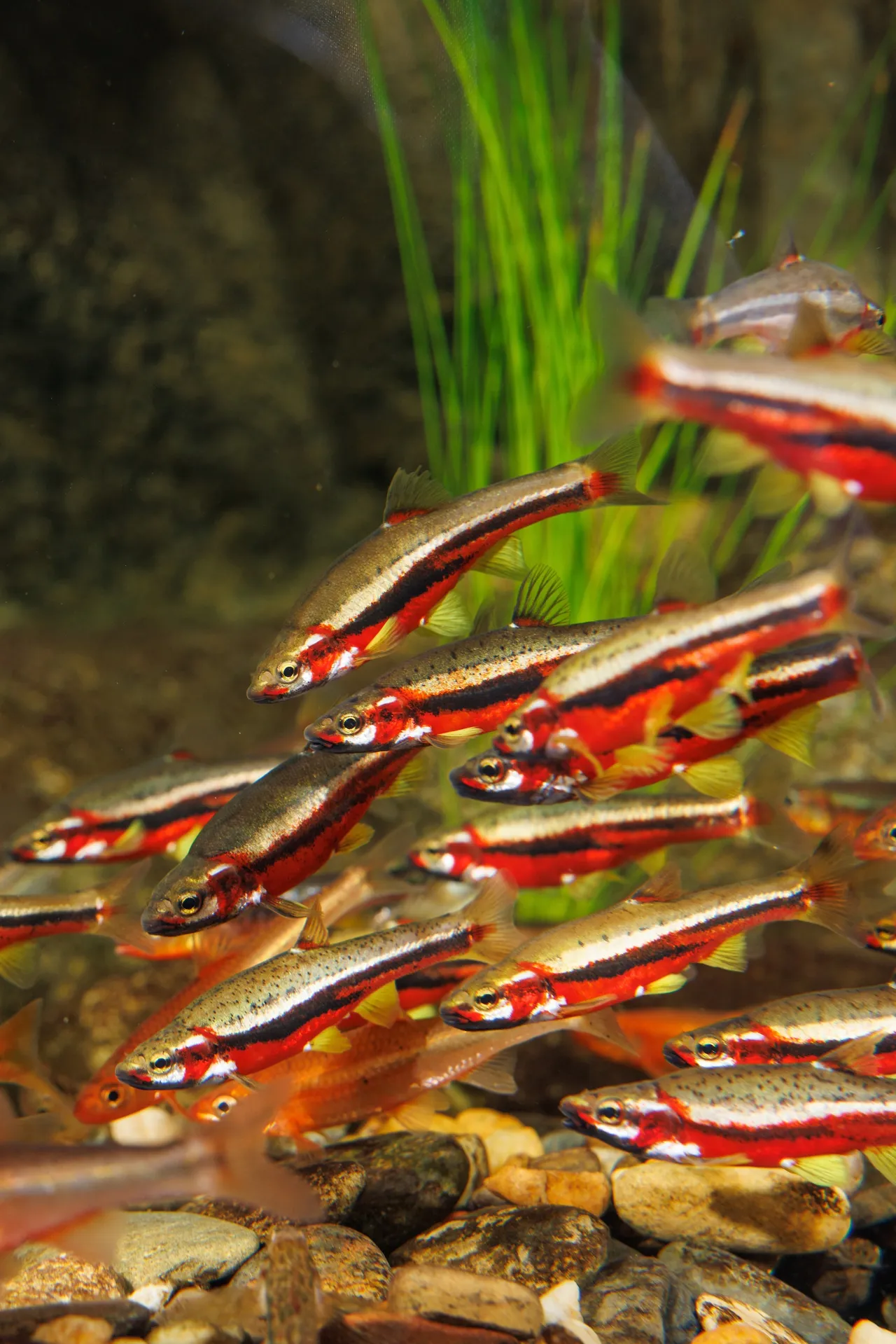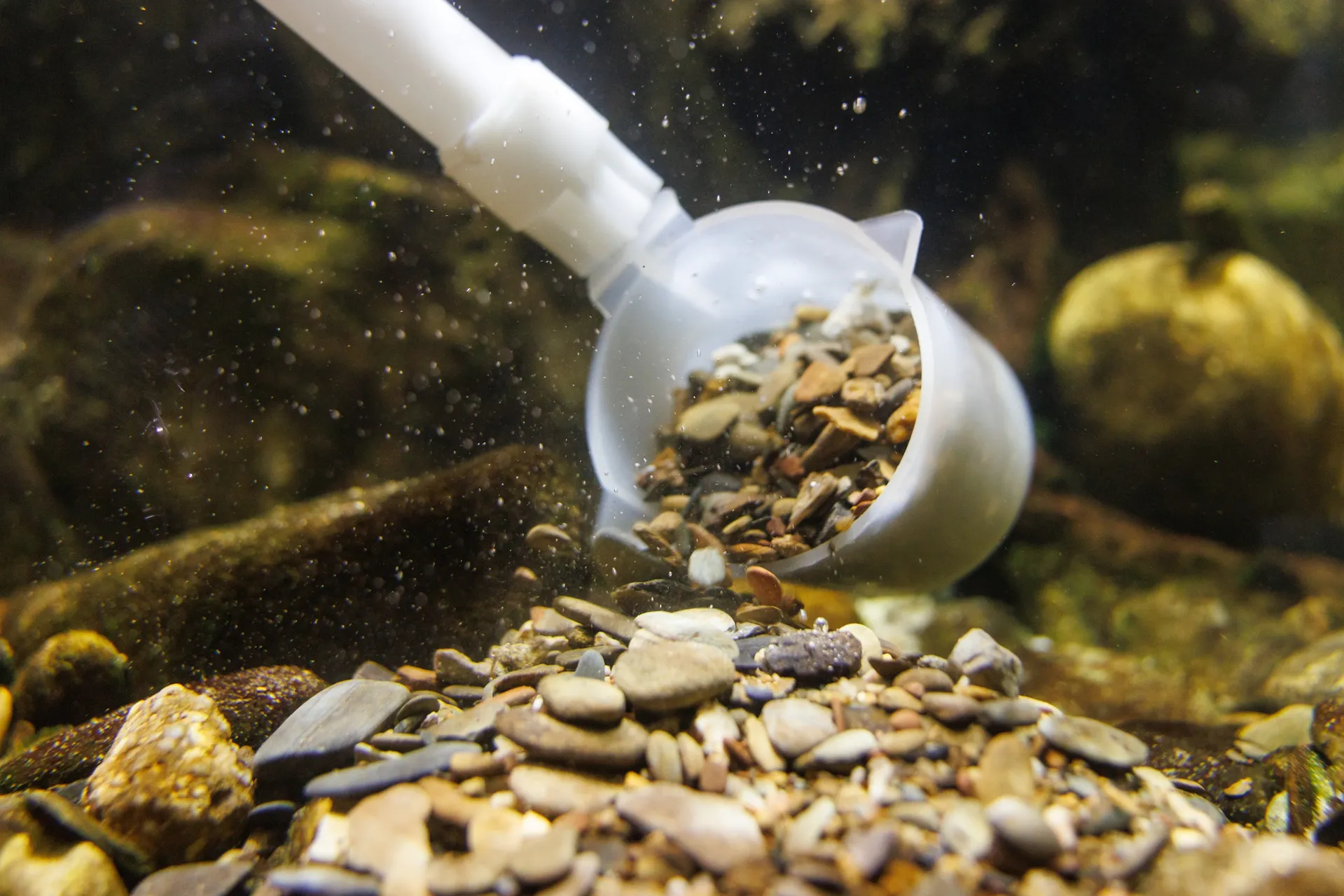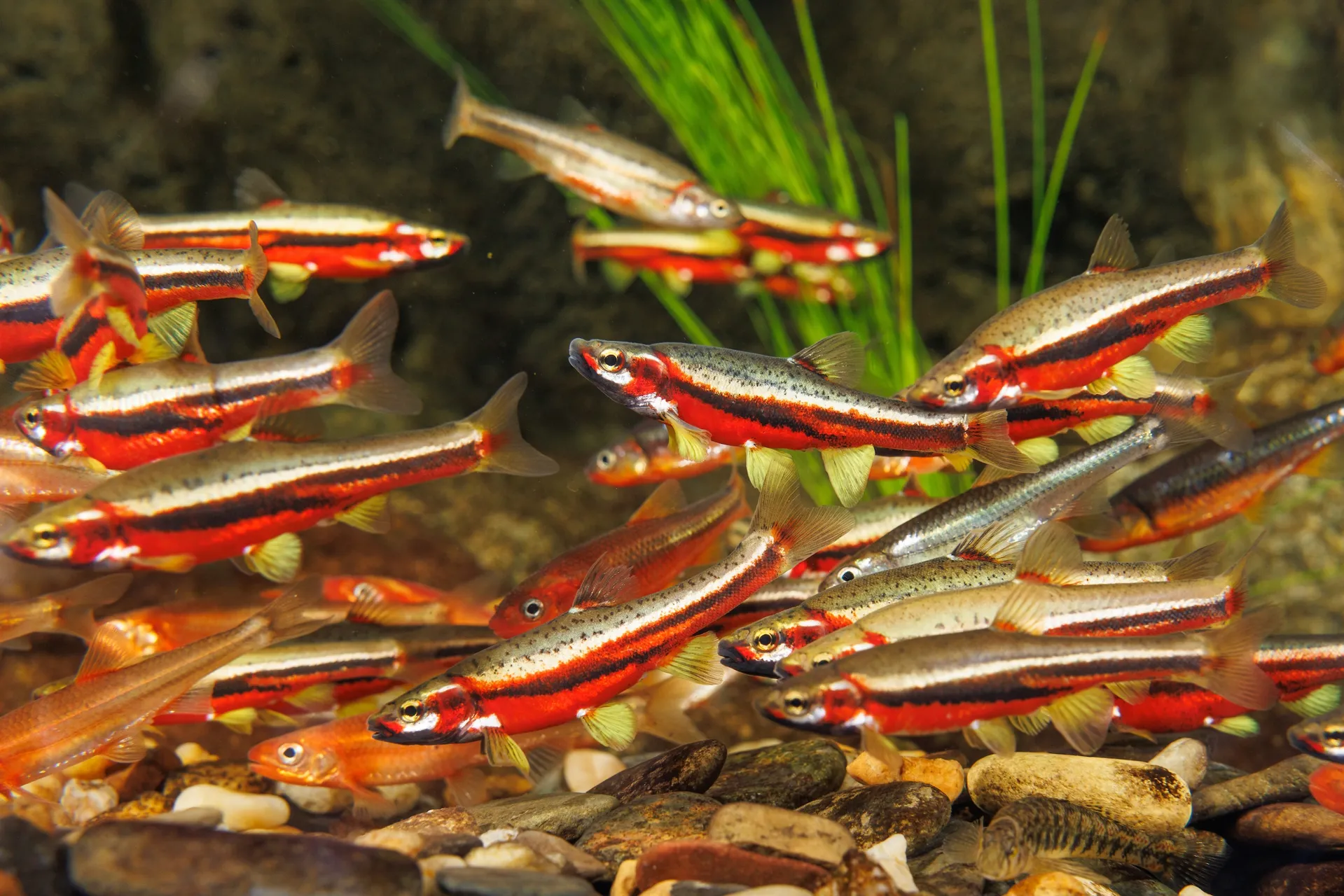Every spring, male River Chubs hoping to breed have a minnow-sized mountain of work ahead of them.
In order to attract a female, these minuscule fish need to create an appealing, safe place to spawn without the benefit of limbs or tools to aid them. Instead, male River Chubs use their mouth to carry rocks one by one — some of them as large as their own massive heads — to deposit in areas with fast-flowing water. These circular nest mounds can measure several feet across and are made from stones that collectively weigh hundreds of pounds.
That’s pretty impressive work for a fish that’s less than a foot long.
River Chub nests don’t just benefit their makers, though. Many other stream-dwelling species, such as Rosyside Dace and Warpaint Shiners, spawn their own eggs in these sheltered, well-oxygenated havens.
In a sense, then, River Chubs are like the civil engineers and event planners of Southern Appalachian streams. Their industrious homesteading sparks a community-level frenzy of activity and brilliant bursts of color from other spawning fish.
Without the benefit of a snorkel, a dive mask and the knowledge of where to look, however, most people never witness this natural spectacle. As team members of a freshwater-focused aquarium in the heart of the Southeast’s underwater rainforest, that’s something many at the Tennessee Aquarium have long dreamed of changing.
“In 2006, I began taking snorkeling very seriously, going out every weekend and seeing what was out there,” says Senior Aquarist Ben Stenger. “I wanted people who weren’t able to do that to see what I was seeing. I wanted that so badly.
“I’m sure there are fishermen who walk in streams next to these breeding events and don’t even realize it. It’s all about getting people to look under the surface.”
This spring, he finally got his wish.
River Chubs are like the civil engineers and event planners of Southern Appalachian streams. Their industrious homesteading sparks a community-level frenzy of activity and brilliant bursts of color from other spawning fish.

‘TOO GOOD TO BE TRUE’
The centerpiece of the Tennessee Aquarium’s newest gallery, Ridges to Rivers, is a 22-foot-long replica of the kinds of upland streams that feed into the Upper Tennessee River. More than two dozen species of fish live in this exhibit, which transitions from cascading falls to deep pools to fast-flowing riffles and runs.
In April, just over a year after the gallery opened, its caretaker, Aquarist II Avery Millard, noticed signs that a male River Chub was beginning to build a nest in the stream exhibit. After clearing an area of sand, he began single-mindedly lining this depression with stones he moved, by mouth, from all over the exhibit.
“At first, I thought it was too good to be true, but then it happened,” Millard recalls, laughing.
As the chub’s nest took shape over the next week, it had a dramatic effect on the rest of the exhibit. Tennessee Shiners, Tennessee Dace and Saffron Shiners eager to spawn took on brilliant red, orange and yellow breeding regalia and hovered over the nest in a tight ball.
It was captivating.
It was utterly natural.
It was like magic, Millard says.
“That was the loftiest goal we could hope for in that exhibit,” she says. “It was kind of surreal seeing them actually doing what we wanted them to do.”
BY DESIGN
The chain-reaction spawning event in Ridges to Rivers was — if not unprecedented — extremely unusual for an aquarium, but it didn’t happen by accident. It was the realization of years of research, careful planning and intentional exhibit design.
Two years before guests were able to walk through the gallery, Millard and Stenger were hard at work troubleshooting the design of the large stream exhibit using an exact replica constructed at an off-site warehouse by the Aquarium’s maintenance team. This one-to-one prototype made from plywood, gravel, pond liner, cinderblocks and hoses was funded by a $140,000 grant through the Institute of Museum and Library Services’ Museums for America program.
Recreating habitats that are as close as possible to those in the wild is vital to the animals feeling at home, thus improving the odds of them engaging in instinctual activities such as spawning and nest building.
“We are so grateful for the support we received from IMLS,” says Melanie King, the Aquarium’s vice president and chief development officer. “Those funds allowed our husbandry and exhibit teams to test and build a world-class habitat that mimics a natural stream and gives the animals in our care the best possible conditions to thrive in.
“The extensive research and design afforded by this grant paid off, as we now witness this incredible naturalistic behavior.”
The exhibit also incorporates a suite of scene-setting controls that allow Millard and the Aquarium’s operations team to make gradual changes to reflect transitions between seasons.
From December to February, the stream experienced “winter,” with temperatures in the high 50s, lower water flow and shorter periods of light. In preparation for the spring spawn, the temperatures increased 10 degrees over the course of two months, accompanied by longer days and higher flow to mimic vernal downpours.
In short, the stream is as close to a wild waterway as the Aquarium can get, says Thom Demas, the Aquarium’s vice president and chief husbandry and exhibits officer
“It’s a real stream, and we have fish behavior to prove it,” he says. “Avery and Ben figured all of that out working at the warehouse, which is incredible.”



A LIVING ECOSYSTEM
The prototype exhibit was an important facet of the design process, but field research played a significant role as well.
Leading up to the opening of Ridges to Rivers, Stenger and Millard spent extensive time snorkeling in Southern Appalachian streams within a few hours’ drive of Chattanooga. During these trips, they researched the underwater topography of these waterways and how animals behaved at various depths and currents. Even the rocks used by the nest-building River Chub were sourced from the same locations at which the exhibit’s residents were collected.
With the benefit of these first-hand observations and with the luxury of time to fine tune the stream design, the Aquarium’s exhibit is as close to the real thing as possible, Stenger says.
“Sometimes, exhibits are just a system where the fish live, and that’s it. The fish are happy and people come to see them, and that’s OK,” he says. “We wanted this to be a living ecosystem.”
NOT AN END, A BEGINNING
Being able to shine a spotlight on the rich aquatic biodiversity of Southern Appalachia has been a career ambition for many Aquarium staff members. For them, witnessing the stream’s community level spawning event was a milestone, not only for the Aquarium but for them, personally.
“When all the aquarists working on the gallery were planning the exhibit, we were saying, ‘I think we can do this and make it work,’” says Curator of Fishes Matt Hamilton. “To see natural behaviors consistently in this exhibit is what we truly hoped would happen. To see it all come to fruition is awe-inspiring.”
Despite the long path that culminated in the River Chub beginning to build his nest, this spawning event was by no means an end point. Now that natural behaviors have been observed in the exhibit, the question has shifted to next steps.
Will the fish spawn again?
Will aquarists be able to collect the eggs?
Can they successfully raise the fry once they hatch?
The prospect of so many unknowns is as exciting as it is daunting, Stenger says.
“I’ve learned so much new stuff in the last week and a half, and I didn’t even have to get wet to do it,” he laughs. “From here on out, we’ll be constantly learning. We’re not done.”
